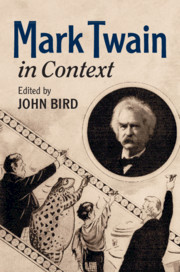Book contents
- Mark Twain in Context
- Mark Twain in Context
- Copyright page
- Contents
- Figures
- Contributors
- Preface
- Acknowledgments
- Chronology
- Abbreviations
- Part I Life
- Part II Literary Contexts
- Part III Historical and Cultural Contexts
- Chapter 15 Politics
- Chapter 16 Business and Economics
- Chapter 17 Religion
- Chapter 18 Science and Technology
- Chapter 19 Race and Ethnicity
- Chapter 20 Race and Ethnicity
- Chapter 21 Race and Ethnicity
- Chapter 22 Cosmopolitanism
- Chapter 23 Gender Issues
- Chapter 24 Gender Issues
- Chapter 25 History
- Chapter 26 Animals and Animal Rights
- Chapter 27 Nationalism and Anti-Imperialism
- Chapter 28 Philosophy
- Part IV Reception and Criticism
- Part V Historical, Creative, and Cultural Legacies
- Further Reading
- Index
- References
Chapter 18 - Science and Technology
from Part III - Historical and Cultural Contexts
Published online by Cambridge University Press: 12 December 2019
- Mark Twain in Context
- Mark Twain in Context
- Copyright page
- Contents
- Figures
- Contributors
- Preface
- Acknowledgments
- Chronology
- Abbreviations
- Part I Life
- Part II Literary Contexts
- Part III Historical and Cultural Contexts
- Chapter 15 Politics
- Chapter 16 Business and Economics
- Chapter 17 Religion
- Chapter 18 Science and Technology
- Chapter 19 Race and Ethnicity
- Chapter 20 Race and Ethnicity
- Chapter 21 Race and Ethnicity
- Chapter 22 Cosmopolitanism
- Chapter 23 Gender Issues
- Chapter 24 Gender Issues
- Chapter 25 History
- Chapter 26 Animals and Animal Rights
- Chapter 27 Nationalism and Anti-Imperialism
- Chapter 28 Philosophy
- Part IV Reception and Criticism
- Part V Historical, Creative, and Cultural Legacies
- Further Reading
- Index
- References
Summary
Mark Twain lived in an era of profound scientific and technological change, in which he was very interested. He followed the debate over evolution, with wide reading in Darwin and other scientists. He also kept up with advances in geology, and he was involved in geological and archeological digs. He was an avid reader in natural history, with a special interest in insects. His interest in science found its way into his writing, such as the key use of fingerprinting in Pudd’nhead Wilson, and especially in his late unpublished writing, when he contrasted science with religion. Twain was keenly interested in technology and inventions, and he was an early adopter of inventions like the typewriter, the telephone (he claimed to have the first telephone in a private residence), and the bicycle, among others. He was a friend to both Thomas Edison and Nicola Tesla, visiting Tesla’s laboratory to be involved with experiments in electricity, and allowing Edison to both record his voice and film him with his moving camera.
- Type
- Chapter
- Information
- Mark Twain in Context , pp. 182 - 191Publisher: Cambridge University PressPrint publication year: 2020

